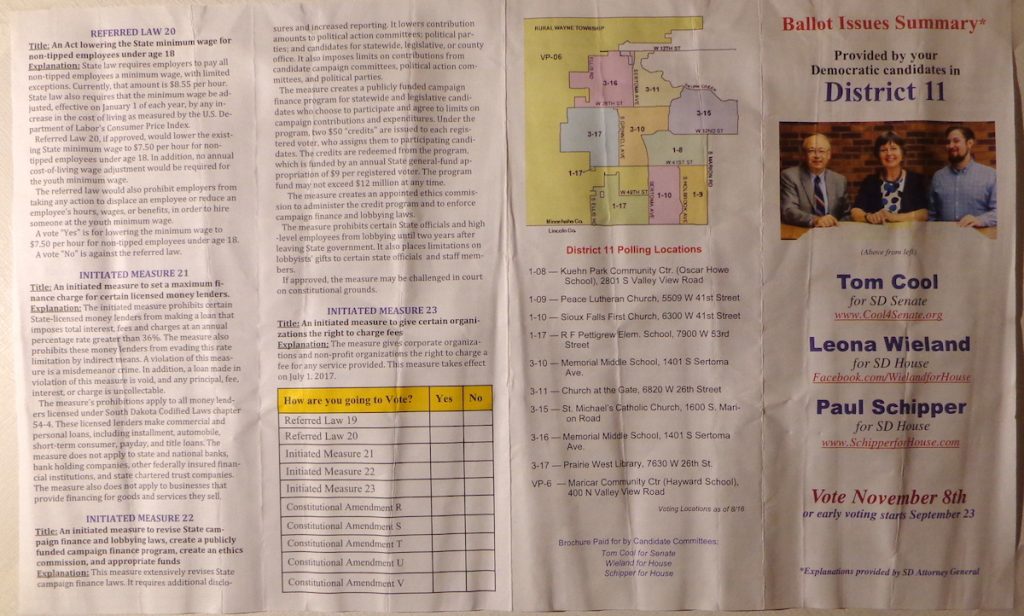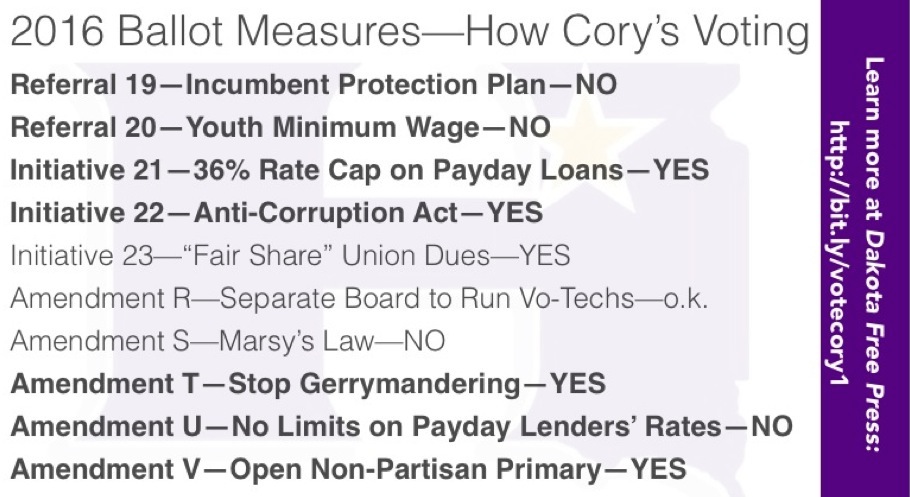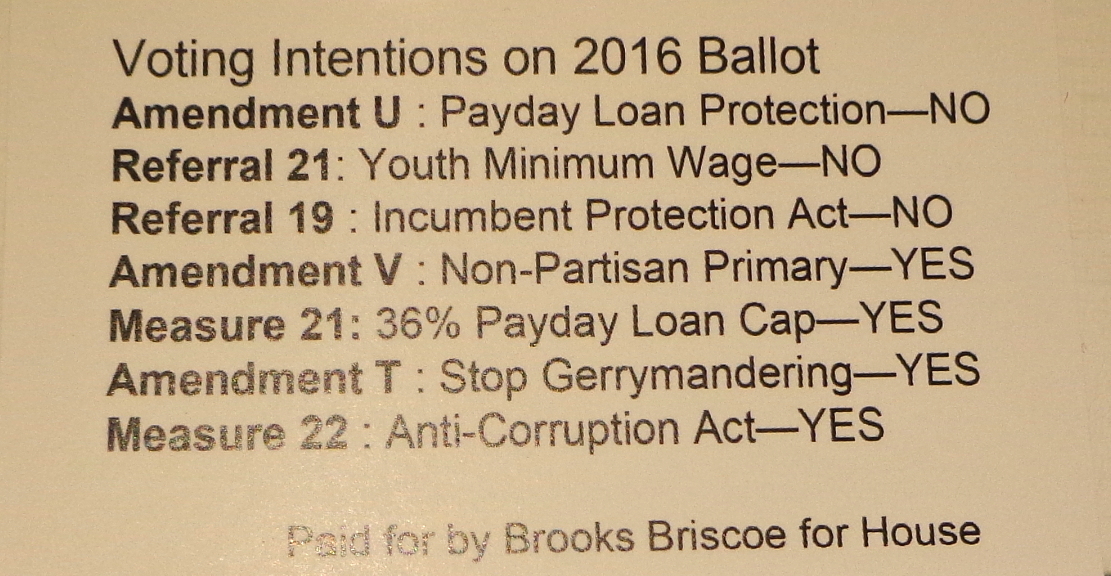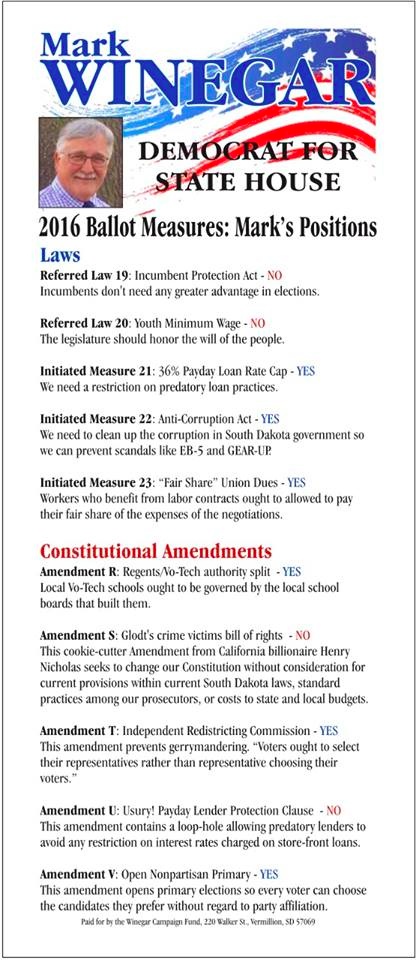I have regularly recommended that South Dakota Democrats seek synergy with ballot measures. Discussing ballot questions gets us away from personal attacks. Given the opportunity to vote on policy, South Dakotans tend to vote Democratic; we just need to get South Dakotans to make the connection between good policy and good Democrats who will offer them more of that policy.
As I run for District 3 Senate, I’ve been handing out my ballot measure guide on every campaign card:
District 3 House candidate Brooks Briscoe is doing the same thing, focusing on seven of the ten measures he finds most important:
District 17 House candidate Mark Winegar offers his constituents a bit more detail on each measure:
District 11 candidates Tom Cool, Paul Schipper, and Leona Wieland are collaborating on a voter information pamphlet with the titles and Attorney General’s explanations for each measure, plus a handy checklist for voters to take with them to the polls:

As the District 11 Democratic flyer shows, ballot measure synergy doesn’t come just from persuading voters to pick the Yea or Nay that we Democrats want on each initiative and referendum (and while Brooks, Mark, and I line up pretty well, there is no Democratic unity on all ten measures). We Democrats perform a public service by informing voters on the ballot measures and helping them find additional resources. We remind voters that we are the party that listens to what they have to say at the polls. We Democrats say to voters, “Read more, learn more, and come vote,” with confidence that the more people learn and the more they vote, the better our democracy will be.
And when we remind voters that we Democrats are the party of democracy, the party that believes in voters, we’ll see more voters believing in us.
By the way, I don’t see any information about ballot measures on the websites of District 3 candidates Rep. Dan Kaiser, Rep. Al Novstrup, or Drew Dennert. Novstrup’s campaign handout mostly copies his somewhat inaccurate website. I’ll keep an eye out for other campaign literature to see if our Republican neighbors offer voters guidance on the ballot measures.



As a public service to the citizens living in Mr. Wingar’s district, his position on Amendment R (vote YES) is opposite his explanation. He says: “Local Vo-Tech schools ought to be governed by the local schools boards that built them.” If that is his belief, voters should vote NO.
For further clarification, the last paragraph of the AG explanation is: “A vote “No” will leave the Constitution as it is.” In other words, it will allow the SF, RC, Mitchell and Wtn School Boards to continue to govern the tech schools as they always have.
On the other hand, a YES vote modifies the constitution to allow for development of a new board to specifically govern the state’s four technical institutes.
I appreciate your close attention to Mark’s flyer, Fred. I would suggest, however, that he reads R correctly. Local school boards run the vo-techs in the status quo, but only because no one has pressed the issue that the constitutiona currently indicates the Regents should be in charge of all post-secondary education. Voting No on R would leave that language in place and leave the door open for the Regents to press the issue. Voting Yes on R means revising the constitution to make clear that Regents keep their hands off the vo-techs and the Legislature designates the separate governing entity/entities for vo-techs.
Interestingly, neither vote guarantees that the local school boards hold onto the vo-techs. Voting Yes on R gives the power to the Legislature to determine vo-tech governance, and who knows what governance model we’ll approve next year. Indeed, the Legislature might create a new governing board to manage all four vo-techs as a unified system. But the Legislature could also leave the vo-techs in the four school districts’ hands. Voting No on R leaves the vo-techs’ fate to the continued non-nitpickery of the Regents… a rather arbitrary prospect, wouldn’t you say?
A no vote keeps the constitution as it is and allows South Dakota k-12 school districts to continue to govern technical institutes. As an interesting side note, South Dakota is the only state in the nation that provides for the dual governance of technical institutes and k-12 school systems by a local school board.
A yes vote — the position supported by the majority of Republicans I know, and apparently at least you and Mr. Winegar on the Democrat side — allows for the formation of a new state board to govern the four state technical institutes independent of the community’s k-12 school board.
I am voting yes on R. Good to see you are too.
I say leave things as they R, so to speak. If the legislatures get into this you know they will increase government and create this new giant bureaucracy to gobble up more tax dollars and do nothing. They will start whining about paying teachers more and building a new 5th technical school and probably want to raise taxes another half-penny to pay for it all.
BAH on R!
I can live with a Yes… but I hear from tech school proponents that a No does not allow the K-12 school districts to keep running the tech schools. That’s exactly the problem: the current governance system is technically unconstitutional. No one has bothered to challenge the status quo, but without R, a challenge could succeed.